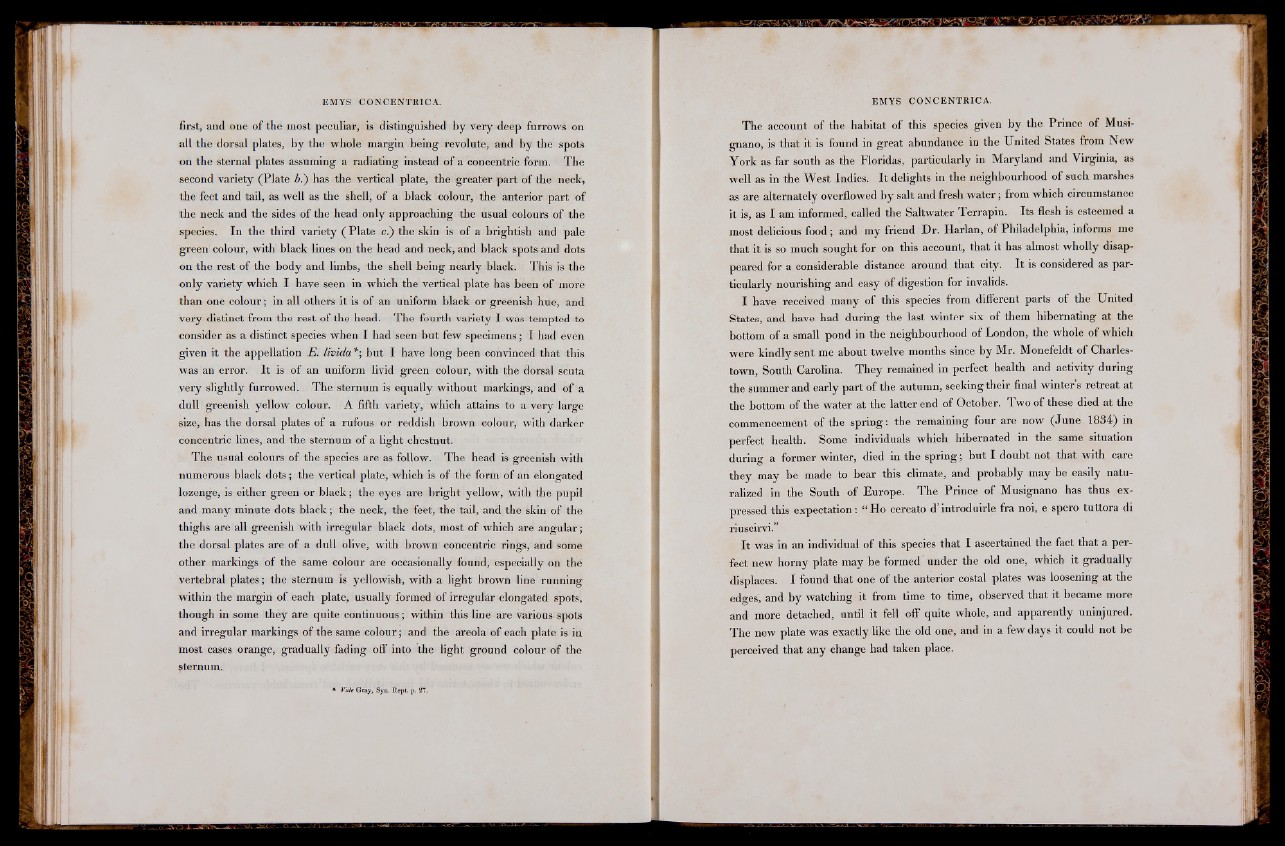
EMYS CONCENTRICA.
first, and one of the most peculiar, is distinguished by very deep furrows on
all the dorsal plates, by the whole margin being revolute, and by the spots
on the sternal plates assuming a radiating instead of a concentric form. The
second variety (Plate b.) has the vertical plate, the greater part of the neck,
the feet and tail, as well as the shell, of a black colour, the anterior part of
the neck and the sides of the head only approaching the usual colours of the
species. In the third variety ( Plate e.) the skin is of a brightish and pale
green colour, with black lines on the head and neck, and black spots and dots
on the rest of the body and limbs, the shell being nearly black. This is the
only variety which I have seen in which the vertical plate has been of more
than one colour ; in all others it is of an uniform black or greenish hue, and
very distinct from the rest of the head. The fourth variety I was tempted to
consider as a distinct species when I had seen but few specimens; I had even
given it the appellation E. livida*; but I have long been convinced that this
was an error. It is of an uniform livid green colour, with the dorsal scuta
very slightly furrowed. The sternum is equally without markings, and of a
dull greenish yellow colour. A fifth variety, which attains to a very large
size, has the dorsal platés of a rufous or reddish brown colour, with darker
concentric lines, and the sternum of a light chestnut.
The usual colours of the species are as follow. The head is greenish with
numerous black dots ; the vertical plate, which is of the form of an elongated
lozenge, is either green or black ; the eyes are bright yellow, with the pupil
and many minute dots black ; the neck, the feet, the tail, and the skin of the
thighs are all greenish with irregular black dots, most of which are angular ;
the dorsal plates are of a dull olive, with brown concentric rings, and some
other markings of the same colour are occasionally found, especially on the'
vertebral plates; the sternum is yellowish, with a light brown line running
within the margin of each plate, usually formed of irregular elongated spots*
though in some they are quite continuous; within this line are various spots
and irregular markings of the same colour; and thé ; areola of each plate is in
most cases orange, gradually fading oif into the light ground colour of the
Sternum.
* Vide Gray, Syn, Rept. p. 27.
EMYS CONCENTRICA.
The account of the habitat of this species given by the Prince of Musi-
gnano, is that it is found in great abundance in the United States from New
York as far south as the Floridas, particularly in Maryland and Virginia, as
well as in the West Indies. It delights in the neighbourhood of such marshes
as aré alternately overflowed by salt and fresh water; from which circumstance
it is, as I am informed, called the Saltwater Terrapin. Its flesh is esteemed a
most delicious food; and my friend Dr. Harlan, of Philadelphia, informs me
that it is so much sought for on this account, that it has almost wholly disappeared
for a considerable distance around that city. It is considered as particularly
nourishing and easy of digestion for invalids.
I have received many of this species from different parts of the United
States, and have had during the last winter six of them hibernating at the
bottom of a small pond in the neighbourhood of London, the whole of which
were kindly sent me about twelve months since by Mv. IMonefeldt of Charlestown,
South Carolina. They remained in perfect health and activity during
the summer and early part of the autumn, seeking their final winters retreat at
the bottom of the water at the latter end of October. Two of these died at the
commencement of the spring: the remaining four are now (June 1834) in
perfect health. Some individuals which hibernated in the same situation
during a former winter, died in the spring; but I doubt not that with care
they may be made to bear this climate, and probably may be easily naturalized
in the South of Europe. The Prince of Musignano has thus expressed
this expectation: “Ho cercato d’introduirle fra noi, e spero tuttora di
riuscirvi. ’
It was in an individual of this species that I ascertained the fact that a perfect
new horny plate may be formed under the old one, which it gradually
displaces. I found that one of the anterior costal plates was loosening at the
edges, and by watching it from time to time, observed that it became more
and more detached, until it fell off quite whole, and apparently uninjured.
The new plate was exactly like the old one, and in a few days it could not be
perceived that any change had taken place.